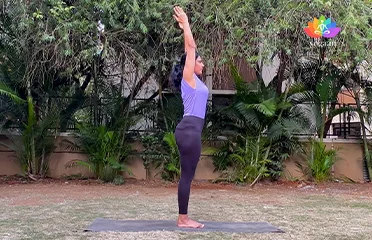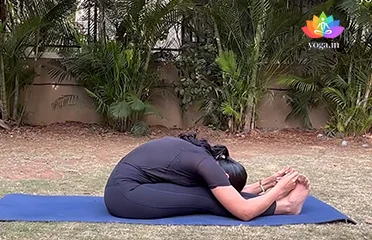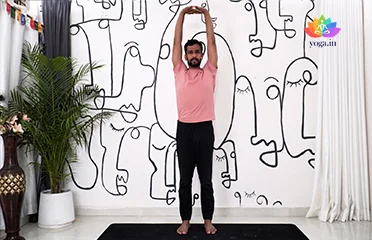Hastapadasana (Hand to Foot Pose)
हस्तपदासन / Hand to Foot Pose
The sanskrit name is derived from hasta (हस्त) means hands, pada (पदा) [�K]
Jathara Parivartanasana (The Abdominal T
ञठर परिवर्तनासन / The Abdominal Twist
The Sanskrit name is derived from Jathara (ञठर) meaning belly or abdomen, [�K]
Paschimottanasana (Seated Forward Bend)
पश्चिमोत्तानासन / Seated Forward Bend
The Sanskrit name is derived from three sanskrit words: Paschima (पश्चिमा) [�K]
Samakonasana (The Right-Angle Posture)
समकोणासन / The Right-Angle Posture
The Sanskrit name is derived from Sama (समा) meaning straight, Kona meaning [�K]
Sarvangasana (Shoulderstand)
सर्वाङ्गासनI / Shoulderstand
The Sanskrit name is derived from Sarva (सर्वाङ्ग) meaning all, [�K]
Simhasana (Lion Pose)
सिंहासना / Lion Pose
The Sanskrit name is derived from Simha (सिंहा) which means lion and [�K]
Sirsasana (Headstand)
शीर्षासन / Headstand
The Sanskrit name is derived from Sirsa (शीर्ष) meaning head and asana [�K]
Tadasana (Mountain Pose)
ताड़ासन / Mountain Pose
The sanskrit name is derived from tada (ताड़ा) meaning mountain and [�K]
How Yoga Can Help Cure Halitosis:
Halitosis, commonly known as bad breath, can be an embarrassing condition affecting personal and social interactions. Yoga can aid in the treatment and relief of halitosis by promoting overall oral health, reducing stress, and improving digestion. Through specific postures, breathing exercises, and mindfulness practices, yoga can help address some of the underlying causes of halitosis.
Understanding Halitosis:
Halitosis is a condition characterized by an unpleasant odor emanating from the mouth. It can be chronic or occasional, often resulting from poor oral hygiene, dietary habits, or underlying medical conditions. The odor typically originates from the breakdown of food particles by bacteria in the mouth, but can also be due to digestive issues or other health problems.
Yoga’s Role in Relieving Halitosis:
Specific yoga practices can help alleviate the symptoms of halitosis by improving digestion, reducing stress, and promoting oral health. Gentle asanas (postures) can enhance digestion, pranayama (breathing exercises) can reduce oral dryness and improve airflow, and meditation techniques can lower stress levels that may contribute to digestive problems.
Key Factors Contributing to Halitosis:
Several factors can contribute to the development of halitosis, including:
- Poor Oral Hygiene: Inadequate brushing and flossing can leave food particles in the mouth.
- Diet: Consumption of certain foods like garlic and onions can cause bad breath.
- Dry Mouth: Reduced saliva production can lead to bacterial growth.
- Medical Conditions: Issues such as sinus infections or gastrointestinal problems.
- Tobacco Use: Smoking or chewing tobacco can lead to persistent bad breath.
Symptoms of Halitosis:
Common symptoms of halitosis include:
- Persistent Bad Breath: A foul odor that does not go away with regular brushing and flossing.
- Unpleasant Taste: A sour or metallic taste in the mouth.
- Dry Mouth: A feeling of dryness in the mouth, often leading to bad breath.
- Coated Tongue: A visible coating on the tongue, which can harbor bacteria.
- Gum Disease: Symptoms like swollen, bleeding gums can accompany halitosis.
- Sinus Issues: Postnasal drip or sinus infections can contribute to bad breath.
Treatment of Halitosis through Yoga and Pranayama:
Yoga and pranayama can be effective in managing halitosis. Some beneficial practices include:
Specific Yoga Poses:
- Bhujangasana (Cobra Pose): Improves digestion and reduces acid reflux.
- Vajrasana (Thunderbolt Pose): Aids in digestion and helps reduce bad breath.
Pranayama Exercises:
- Kapalbhati (Skull Shining Breath): Cleanses the respiratory system and improves digestion.
- Anulom Vilom (Alternate Nostril Breathing): Balances the body’s energies and reduces stress.
Diet for Halitosis:
A balanced diet can help manage halitosis. Recommendations include:
- High-Fiber Foods: Fruits and vegetables that promote oral health and fresh breath.
- Hydration: Drinking plenty of water to keep the mouth moist and flush out bacteria.
- Probiotics: Yogurt and other probiotic-rich foods to maintain gut health.
- Avoiding Odor-Causing Foods: Limiting intake of garlic, onions, and spicy foods.
- Herbal Teas: Drinking green tea or herbal teas that have antibacterial properties.
Caution for Halitosis:
While practicing yoga for halitosis, it is essential to:
- Avoid Overexertion: Practice at a gentle pace to prevent stress on the body.
- Be Mindful of Breath: Ensure that breathing exercises are done correctly to avoid dizziness.
Always consult with a healthcare provider before starting any new exercise regimen, especially if you have underlying medical conditions.
Contraindications for Halitosis:
Individuals with certain conditions should:
- Avoid Intense Breathing Exercises: Vigorous pranayama practices might be overwhelming.
- Steer Clear of Certain Poses: Inversions and poses that increase abdominal pressure may cause discomfort.
- Seek Professional Guidance: Consult a yoga therapist or healthcare professional for personalized recommendations.









